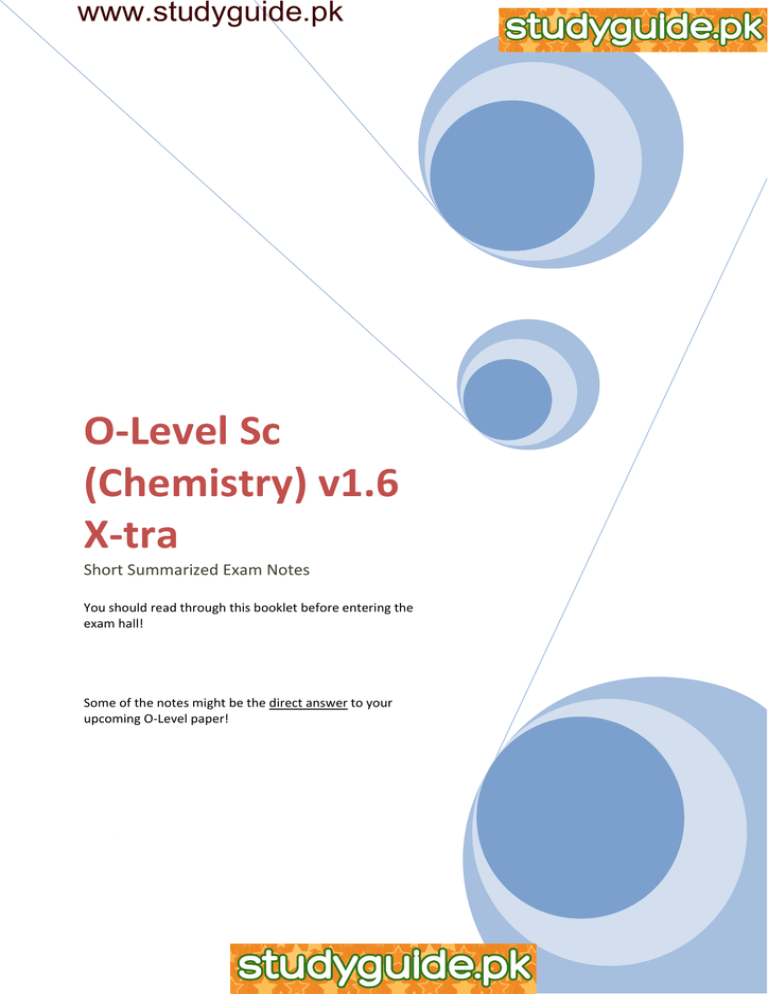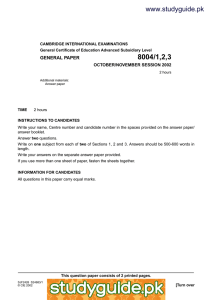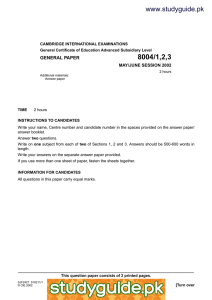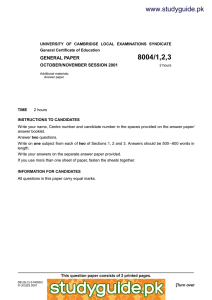
www.studyguide.pk
O‐Level Sc (Chemistry) v1.6 X‐tra Short Summarized Exam Notes You should read through this booklet before entering the exam hall! This booklet contains extra notes have not been included in the “Full Science Chemistry Summarized notes 1.5” booklet. Some of the notes might be the direct answer to your upcoming O‐Level paper! http://www.ray‐revision.webs.com ©RAY‐Notes 2009 February 2009 All Rights Reserved www.studyguide.pk
Copyright: Salman Bhatti
Science (Chemistry) Summarized version 1.6 (Extra Exam Notes Edition) ©RAY‐Notes 2009 (Hard‐copy)
Notice: This exam notes booklet is a follow‐up release after “Science Chemistry Full v1.5” is released on January 2009. If you do not have the version 1.5, it is strongly recommended that you download it free at http://www.ray‐revision.webs.com Use this booklet as a quick revision tool before you enter the exam hall. Any errors or mistakes on the notes should be forwarded to Ray‐Notes® 2009 directly via email. www.studyguide.pk
Science (Chemistry) Summarized version 1.6 (Extra Exam Notes Edition) ©RAY‐Notes 2009 (Hard‐copy)
Remember to draw this out in Chemistry exams! (Solubility tables from your textbooks are harder to memorise) Soluble
Insoluble
Nitrate
All
-
Sulfate
Rest
Ba, Ca, Pb
Chloride
Rest
Ag, Pb
Carbonate
Group1
Rest
Remember via: “Baked Chicken Pasta At Pastamania” ’Secret’ Table contributed by Ms Aida (BtVSS, MOE Singapore) This table helps you know whether a salt is soluble or not. Below: Preview of the Modified Periodic Table. Full version available for free download at Ray‐revision.webs.com www.studyguide.pk
Science (Chemistry) Summarized version 1.6 (Extra Exam Notes Edition) ©RAY‐Notes 2009 (Hard‐copy)
Testing for CATIONS: With this table, you don’t need to memorise the colours of different salts! Just draw out this table during your O‐Levels CATION NaOH NH3 Colour
Soluble or
Insoluble
Colour
Soluble or
Insoluble
Cu2+
B
I
B
S
Fe2+
G
I
G
I
Fe3+
R
I
R
I
Ca2+
W
I
-
-
NH4+
N
-
-
-
Zn2+
W
S
W
S
Al3+
W
S
W
I
Pb2+
W
S
W
I
Colour of Observation Soluble or Insoluble in excess Alkali
The CATIONS table shows the colour changes observed when the salt is added to Sodium Hydroxide, NaOH, or Aqueous Ammonia, NH3. Testing for ANIONS: ANION Chlorine Tested with AgNO3 Observations AgCl White Carbonate Acid CO2 Sulphate Ba(NO3) BaSO4 Carbon Dioxide (Turn Limewater chalky) White Nitrate Al, NaOH NH3 Iodide Pb(NO3)2 PbI2 Ammonia (Turn red litmus blue) Yellow www.studyguide.pk
Science (Chemistry) Summarized version 1.6 (Extra Exam Notes Edition) ©RAY‐Notes 2009 (Hard‐copy)
Test for GASES: •
Ammonia → Use damp litmus Paper → Turns from red to blue •
Carbon Dioxide → Use Limewater → White ppt formed (Turns Chalky) •
Chlorine → Use Damp blue litmus paper → Bleaches Litmus paper (Litmus Turns colourless) •
Hydrogen → Use Burning Splint → 'Pop' Sound Heard •
Oxygen → Use Glowing Splint → Glows Brighter or Burst into flames •
Sulphur Dioxide → Place a drop of Potassium Dichromate(VI) on Filter paper ‐ Orange Dichromate turns green. _________________________________________________________________________________ Mole Concept - Memorise this 4 IMPORTANT Formulas:
Mass of Sample
No. of Mole Molar
Mass Mole Volume Concentration No. of Volume of Particles
Gas No. of No. of
23
Mole 6x10
Mole 24dm3
www.studyguide.pk
Science (Chemistry) Summarized version 1.6 (Extra Exam Notes Edition) ©RAY‐Notes 2009 (Hard‐copy)
Random Notes Some Properties of All acidic solutions 1. All acids change blue litmus red 2. Acids react with metals which are above hydrogen in the reactivity series. 3. Acid reacts with bases to form salt and water. Uses of Ammonia 1) Manufacture of nitric acid 2) Used to produce fertilisers Note: • Hydrogen can be used as a fuel! • Ehtene (Alkene) is used to make plastic Potassium Dichromate (VI) •
•
•
Acts as an oxidising agent. If something is oxidised, it will turn from orange to green! Used to test for Sulphur Dioxide – Place a drop on filter paper, colour changes from orange to green. *Note: Potassium Dichromate turns from Orange to green when Alcohol is present! ‐ Because P.D, which is an oxidising agent, can oxidise “alcohol into organic acid”. And P.D turns green whenever something is oxidised. Potassium Iodide •
•
Acts as an reducing agent. If something is reduced, it will turn from colourless to brown! (* or if an Oxidising agent is present) Uses of Ethanol 1) Solvent for organic compounds. 2) To make alcoholic drinks. Note: Something that contains more carbon content is stronger! www.studyguide.pk
Science (Chemistry) Summarized version 1.6 (Extra Exam Notes Edition) ©RAY‐Notes 2009 (Hard‐copy)
Some Reaction requirements: 1)
•
•
•
2)
•
•
•
3)
•
Fermentation 37oC Enzymes No Oxygen present Alkene addition of steam, to become alcohol Phosphoric acid (Catalyst) 300oC High temperature/pressure! Alkene addition of Hydrogen, to become Alkane Nickel Catalyst Fractional Distillation of Petroleum (Please update pg 43 of version 1.5 with this ideal answer below) Important Process (Better Answer): 1) The crude oil is separated into different fractions by fractional distillation 2) The crude oil is boiled. Each fraction boils at a different temperature. 3) The smaller, lighter molecules separate at low boiling points. The heavier parts have higher boiling points. 4) The fractions are run off from the fractionating colomn at different boiling points. General Links Electical Conductivity – Moving Ions Heat Conductivity – Free Moving electrons Boiling point – Strong electrostatic attraction www.studyguide.pk
Science (Chemistry) Summarized version 1.6 (Extra Exam Notes Edition) ©RAY‐Notes 2009 (Hard‐copy)
Why Ionic got high B.P? 1) Ionic compounds consist entirely of ions. 2) The opposite charged ions are held close to one another by very strong electrostatic attraction, known as ionic bonds. 3) Hence large amount of energy is needed to break ionic bonds; Therefore high boiling point. Why Covalent Low BP? 1) Covalent compounds consist entirely of molecules as they are formed by sharing of electrons. 2) Forces between molecules are very weak. 3) Hence only small amount of energy is needed to break bonds. Why Ionic compounds conduct in Molten/Aqueous state? •
The ions become free to move about and can convey charges. # Why cannot conduct in Solid state? •
The ions are fixed rigidly by strong electrostatic attraction hence cannot conduct electricity. Why attaching Magnesium to underground pipe increase working life? (About Sacrificial Protection – Prevention of rusting)
Magnesium is above iron in the reactivity series. Water will react with Magnesium instead of iron, and Magnesium gets worn out. Iron rusting is much reduced. This is known as Sacrificial Protection #Why cannot use copper instead of Magnesium??
Copper is below iron in the reactivity series. Hence Iron rusts faster when copper is attached to iron. Why Hydrogen More reactive (than Helium)?
Hydrogen has 1 valence electron. It can gain one more to become stable. Helium has 2 valence electrons, making it very stable. www.studyguide.pk
Science (Chemistry) Summarized version 1.6 (Extra Exam Notes Edition) ©RAY‐Notes 2009 (Hard‐copy)
Physical Properties of Metals 1. Good conductors of heat and electricity ‐ used to make wires 2. High Bp/Mp ‐ used to make cooling utensils 3. Malleable and Ductile. – used to make jewellery Why is Copper recycled? 1. Copper is expensive 2. Copper is not seen as extensive as some other metals. Naming an Ester When you name or draw the structure of ester, follow this Formula: NOL DAC (Developed by Ms Aida, BtVSS Singapore)
NOL means “Name Alcohol First” DAC means “Draw Acid First” •
So in Ethyl Propanoate (Ester), the one on the left is Alcohol, right is Acid. Ethanol (Alcohol) Propanoic Acid (Acid) •
But when you draw the chemical structure, the Acid part must be on the left side, Alcohol on the right side. __________________________________________________________________ 3 Amphoteric Oxides: 1. Aluminium Oxide 2. Zinc Oxide 3. Lead Oxide www.studyguide.pk
Science (Chemistry) Summarized version 1.6 (Extra Exam Notes Edition) ©RAY‐Notes 2009 (Hard‐copy)
OH O || C ‐ OH
When you see this in a chemical structure, it is an alcohol. When you see this in a chemical structure, it is an Acid Alkane: CnH2n+2 Alkene: CnH2n This new formula works the same as the original! Alcohol: CnH2n+1OH Acid: CnH2n+1CO2H OR CnH2nO2 It is highly recommended you use this formula to avoid confusions. __________________________________________________________________ Oxidation 1.
2.
3.
4.
Gain Oxygen Loss Hydrogen Loss electrons Increase in oxidation state Reduction 1.
2.
3.
4.
Gain hydrogen Gain electron Loss Oxygen Decrease in oxidation state Note: When checking if a something is oxidised or reduced, use the oxidation state to check! This produces 100% Correct answer. If you chose to use the lose/gain of oxygen or electrons, your answer might not be correct. www.studyguide.pk
Science (Chemistry) Summarized version 1.6 (Extra Exam Notes Edition) ©RAY‐Notes 2009 (Hard‐copy)
“Protein undergoes hydrolysis to form amino acids!” Remember 4 alkalis (Soluble oxides/Hydroxides) 1. Potassium Hydroxide 2. Sodium Hydroxide NaOH 3. Calcium Hydroxide Ca(OH)2 4. Ammonia NH3 __________________________________________________________________ Reactivity Series: 1. Potassium 2. Sodium 3. Calcium 4. Magnesium 5. Aluminium 6. Zinc 7. Iron 8. Lead 9. Hydrogen 10.Copper 11.Silver 12.Gold *Just remember the phrase: “Playing soccer can make all zappy, I love Hanna coz she’s gorgeous” www.studyguide.pk
Science (Chemistry) Summarized version 1.6 (Extra Exam Notes Edition) ©RAY‐Notes 2009 (Hard‐copy)
Mr of C60: (Carbon molecule) 12 x 60 = 720 __________________________________________________________________ Exothermic • Absorb energy Æ Break bonds • Absorb heat Æ Test tube turn cold • Eg. Ice melting to water (Absorb energy to break bonds) Endothermic • Give out energy Æ Bond Forming • Release Heat Æ Test tube turns hot. _____________________________________________________________ “Hydrogen used as a fuel” “Ethene used to make plastics” Solvent suitable for Chromatography: Ethanol __________________________________________________________________ Chemical Reactions in Blast Furnace 1. Coke burns in air to produce carbon dioxide and lots of heat. C + O2 Æ CO2 2. Carbon Dioxide reacts with more coke to produce Carbon Monoxide. C + CO2 Æ 2CO 3. Carbon Monoxide react with iron(III)Oxide to produce molten iron & carbon dioxide. 3CO + Fe2O3 Æ 3CO2 + 2Fe 4. Impurities in molten iron are removed by limestone. CaCO3 Æ CaO + CO2 5. Calcium Oxide formed combines with Silica present in the ore to form slag, which is tapped out. CaO + SiO2 Æ CaSiO3 # Impurity in Blast Furnace: Silica www.studyguide.pk
Science (Chemistry) Summarized version 1.6 (Extra Exam Notes Edition) ©RAY‐Notes 2009 (Hard‐copy)
ALKANE Æ STRONG HEAT Æ ALKENE Process: Cracking Cracking – A reaction in which big hydrogen molecules are broken into
smaller molecules by heat.
______________________________________________________
Group 7 - Halogens
•
•
•
•
•
Fluorine: Pale yellow gas
Chlorine: Yellowish Green gas
Bromine: Reddish Brown liquid
Iodine: Black Solid
Astatine: Black Solid
*Download the “Modified Periodic Table” for more notes on “Periodic Table” http://www.ray‐revision.webs.com Note: when Bromine is added to Iodide, Got reaction! Æ Displacement reaction (Bromine more reactive than Iodide) •
For group 7 elements, the more reactive elements will displace the less reactive elements in reactions. Why plastic cause pollution? •
It is non‐biodegradable _____________________________________________________________________________ Describe a test for Chlorine •
It turns the blue litmus paper red first then white. (Chlorine bleaches litmus paper) How to distinguish which is Acid, which is alcohol • Test: Put some Sodium Carbonate Result for Alcohol: No reaction Result for Acid: A gas is released Because Alcohol does not react with carbonate! Because Acid can react with carbonate “ACID + CARBONATEÆ SALT + WATER + CARBON DIOXIDE GAS www.studyguide.pk
Science (Chemistry) Summarized version 1.6 (Extra Exam Notes Edition) ©RAY‐Notes 2009 (Hard‐copy)
Uses of Noble Gases: 1. Helium: Fill Baloons (Low Density) 2. Neon: Light Tubes 3. Argon: Light Bulbs (unreactive) __________________________________________________________________ *Common questions: Does metal liberate hydrogen from Dilute Hydrochloric Acid? • Yes – More reactive • No – Less reactive Is the metal reduced by heating with carbon? • Yes – Less Reactive • No – More Reactive How does calcium ion show that Calcium is a metal? • Metals form positive ions. Calcium has 3 valence electrons thus it is a metal. ________________________________________________________________ #Methods of preparing salts 1) ‘Titration method’ (For making all group 1 salts) use: Soluble + Soluble 2)
For making soluble salts not from group 1, use: Soluble + Soluble Soluble + Insoluble 3) ‘Precipitation Method’ For making Insoluble salts, use: Soluble + Soluble www.studyguide.pk
Science (Chemistry) Summarized version 1.6 (Extra Exam Notes Edition) ©RAY‐Notes 2009 (Hard‐copy)
steps of preparing salts: Important: Memorise the Titration Method (Soluble Base + Acid)
To prepare any salt that is from Group 1. (Eg. Preparing Sodium Sulfate) 1)
2)
3)
4)
5)
6)
Add 25cm of acid to a conical flask Add a few drops of indicator. (eg. Phenol‐Phthalein) Add Sodium Hydroxide using a burette until indicator changes colour. Repeat experiment with 25cm3 of Sulfuric Acid but NO indicator! Add same volume of Sodium Hydroxide. Sodium Sulfate is obtained by evaporating & crystalising the salt. _____________________________________________________________________________ Precipitation Method (Soluble + Soluble)
To prepare any Insoluble salt. 1)
2)
3)
4)
Add ‘soluble salt’ with ‘soluble salt’. Filter out the precipitate. Wash the residue with distilled water. Leave the residue to dry. ***MUST‐KNOW formulas: Amonium Ammonia Hydroxide Nitrate Carbonate Sulfate Hydrochloric Acid
Sulfuric Acid Nitric Acid Oxygen Sodium Chloride Carbon Dioxide NH4+ NH3 OH‐ NO3‐ CO32‐ SO42‐ HCl H2SO4 HNO3 O2 NaCl CO2 Memorise this template, and replace the underlined words during exams! www.studyguide.pk
Science (Chemistry) Summarized version 1.6 (Extra Exam Notes Edition) ©RAY‐Notes 2009 (Hard‐copy)
Why important to recycle metals? 1) It can help conserve the metal ores in the ground, making it last longer. 2) It saves the money needed for extraction of metals. _______________________________________________________________________ #Why people concentrate on recycling copper? •
Copper is more scarce, hence more expensive than iron. Advantages of Recycling: 1. Metal ores in the ground can last longer. 2. Money saved in energy needed to extract new metals from ore. 3. Scrap metal is removed from the environment, prevents land & water pollution due to corrosion. Disadvantages of Recycling: 1. Expensive to collect strap metals from many sources 2. Metal fumes produced in melting of scrap metals can cause pollution. _______________________________________________________________________ Members of Homologous series have: •
•
Different Empirical formula Different Physical Properties Remember: A base is a metal oxide or hydroxide! _____________________________________________________________________________ #Which compound forms an acidic solution with water?? Ans: Carboxylic Acid ( Acid + Water Æ Acidic Solution) *Note that excess Acid or Alkali can pollute the environment!! If a question asks for the chemical properties of acid, avoid writing “It turns blue litmus paper red” Æ write “acid reacts with base to form...” www.studyguide.pk
Science (Chemistry) Summarized version 1.6 (Extra Exam Notes Edition) ©RAY‐Notes 2009 (Hard‐copy)
Effects of acid rain 1) Corrodes cement and stones used in buildings 2) Kills fishes in fresh water lakes. 3) Makes agricultural land acidic resulting in crops growing poorly. Important Tip: Any question that wants you to write the Ionic Equation of any “neutralisation” reaction, just write this out: +
‐
H + OH Æ H2O ___________________________________________________ Note that salt do not react with acid! Eg. Copper(II)Nitrate do not react with Sulphuric Acid Salt
However, Copper(II)Oxide will react with Sulphuric Acid! Base + Acid
Æ Got reaction
Chemical Properties of Group 7 elements 1)
2)
3)
4)
All are diatomic molecules. All are coloured. All are oxidising agents. All are non‐metals. Physical Properties of Group 7 elements 1) They have low Mp/Bp 2) They are poor conductor of electricity 3) They are coloured substances, colour become darker down the group www.studyguide.pk
Science (Chemistry) Summarized version 1.6 (Extra Exam Notes Edition) ©RAY‐Notes 2009 (Hard‐copy)
How to remove Sulphur Dioxide from... ... ?? Ans: Use: •
•
Slaked Lime Calcium Hydroxide Acidic Important Note: Isotopes have: •
•
Same chemical properties (Becoz same no. of valence electrons) Different physical properties Info: In chemistry, “Lime” is Alkaline! NOT same as “LEMON”!!! “Irons reacts rapidly in steam, slowly in cold water” __________________________________________________________________ Air •
•
•
•
1% Other Gas (mainly argon) 20% Oxygen 79% Nitrogen Others: CO2, Water Vapour Petroleum Fractions (Fractional Distillation of Petroleum process at Pg 7) 1.
2.
3.
4.
5.
6.
7.
Petroleum ÆCylinder gas for cooking Petrol Æ Fuel for cars Naptha Æ Making Chemicals Kerosene (Paraffin) Æ Jet fuel Diesel Æ Fuel for bus Lubricating Oil Æ Wax, Polishes, Lubricants Bitumen Æ Surfacing roads www.studyguide.pk
Science (Chemistry) Summarized version 1.6 (Extra Exam Notes Edition) ©RAY‐Notes 2009 (Hard‐copy)
Particles Theory Must memorise the following: # Factors affecting speed of reaction 1) Concentration of solution ‐ The higher the concentration of solution, the faster the rate of reaction. ‐ Because the particles are closer together so they collide more frequently and so there were more frequent reactions. Note: Only applies to reactions of solutions. _____________________________________________________________ 2) Pressure ‐ The higher the pressure, th higher is the rate of reaction. ‐ Because the particles are squeezed closer together, so they collide more frequently and so there were more frequent reactions. Note: Only applies to reactions of gases. _____________________________________________________________ 3) Particle size of solid ‐ The smaller the particle size, the higher the rate of reaction. ‐ Because the total surface area of the solid increases so reacting particles of liquid and gases collide more frequently with the surface and so there are more frequent reactions. Note: Only applies to reactions of solids. _____________________________________________________________ 4) Temperature ‐ The higher the temperature, the faster the rate of reaction. ‐ Because at higher temperature, the particles have greater kinetic energy, so they react more often when they collide. www.studyguide.pk
Science (Chemistry) Summarized version 1.6 (Extra Exam Notes Edition) ©RAY‐Notes 2009 (Hard‐copy)
*Methods of extraction ‐The method used depends on how reactive is the metals! Very Reactive Metals Electrolysis For: (Decomposing metal compound with electricity)
Potassium Sodium Calcium Magnesium Aluminium _________________________________________________ Moderately Reactive Metals Heating metal oxide with coke For: Zinc Iron Lead _________________________________________________ Low Reactivity Metals Heating metal compounds in air For: Copper Silver (End of exam notes v1.6 booklet) Found mistakes on notes? Send me an email. Corrections will be made within 2 days. *Hard‐copy notes for other subjects are also available at http://www.ray‐revision.webs.com ©2009 Hong Ray Corporations® All Rights Reserved




